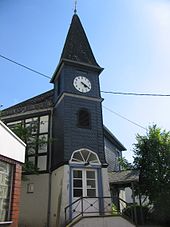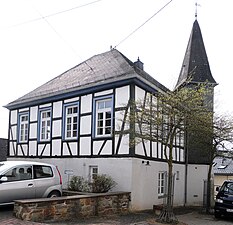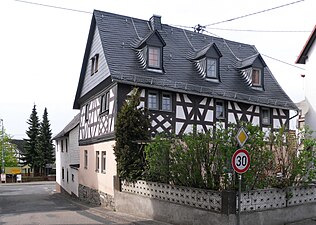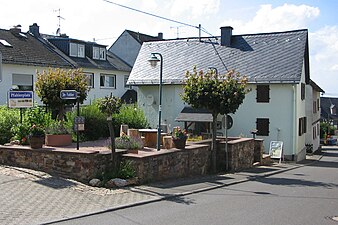House in front of the height
|
House in front of the height
Community of Schlangenbad
|
|
|---|---|
| Coordinates: 50 ° 5 ′ 0 ″ N , 8 ° 2 ′ 37 ″ E | |
| Height : | 479 m above sea level NHN |
| Area : | 6.01 km² |
| Residents : | 722 (Jun. 30, 2013) |
| Population density : | 120 inhabitants / km² |
| Incorporation : | July 1, 1972 |
| Postal code : | 65388 |
| Area code : | 06129 |
|
View of Hausen vd Höhe
|
|
Hausen vor der Höhe is a district of the community Schlangenbad in the southern Hessian Rheingau-Taunus district in Hesse with around 750 inhabitants and was previously recognized as a climatic health resort .
geography
Hausen is located in the Hohe Taunus, directly north of the Taunushauptkamm on the saddle, over which the country road descends at an altitude of 514 meters to Kiedrich in the Rheingau . This pass at the Förster-Bitter-Eiche is the starting point for hikes on the Rheinhöhenweg and along the former Rheingau Gebück . At the same time, the forest road into the hinterland forest begins here . About 1.5 km to the east are the 548 m high Dreibornsköpfe and just under 2 km southwest of the 580 m high Erbacher Kopf .
Many rural and listed half-timbered houses are reminiscent of an agricultural livelihood that no longer exists today. Only a little part-time farming has remained, most of the residents now commute to cities in the Rhine-Main region, primarily to Wiesbaden .
history
About 1.5 km southeast of Hausen in the Kiedrich district is the Dreibornskopf ring wall , which suggests that the area was settled in early history. The oldest surviving documentary mention as Vilula Husen dates from the year 1194. Around 1200 the name Ringravenhusen occurs at times , from which a relationship to the Rhine Counts can be derived. Hausen was one of the Electoral Mainz elevated villages around the main town of Bärstadt . The beginning of the place probably goes back to a rest area or a rest house ("hus by der höhn") on the road between the upper Rheingau and the Wispertal , which was built near the top of the pass .
Due to the through traffic, there have always been inns and craft businesses in Hausen. Wagner and blacksmith worked together, the abundance of wood made it possible for a "pale" to deliver the support posts for the vines in the nearby Rheingau. Forest workers and carters lived here. The Pfahlerplatz in Hausen still bears witness to this tradition.
For a long time, Hausen was the border station between Kurmainz and Hessen-Darmstadt . The border was safely expanded by the so-called Gebück , an impenetrable beech hedge. The southern boundary of the district coincides in parts with the course of this Landwehr, of which small remains of the soil formation and vegetation can still be seen in the forest. At Hausen there was a secured passage for the road from the Rheingau, the fort-like Hauser bulwark (demolished in 1880).
During the Reformation the Protestant denomination was introduced in Hausen, as in the entire Lower County of Katzenelnbogen in Hesse. Some of the Hausener residents come from France. Huguenots had to leave their homeland in the 17th century and came as religious refugees.
At the time of the Duchy of Nassau , Hausen belonged to the Langen-Schwalbach office . After the annexation by Prussia, it was assigned to the Untertaunuskreis in the Wiesbaden administrative district in 1867 .
As part of the regional reform in Hesse , the municipality of Hausen vor der Höhe and other municipalities voluntarily joined the Schlangenbad municipality on July 1, 1972. For the district of Hausen, as for the other districts, a local district with a local advisory board and local councilor was set up.
coat of arms
On October 6, 1971, the municipality of Hausen vor der Höhe in the then Untertaunuskreis was awarded a coat of arms with the following blazon : In green between two silver wheels, a jumping silver stag with red hooves.
Culture
In 1351 a Lady Chapel is attested as a branch of the parish Bärstadt with chaplain, which was described as dilapidated in 1817 and demolished shortly afterwards. In 1753 a school house was built, which the children from Fischbach also attended. After the construction of a larger schoolhouse in 1882, the old school was used as the town hall from then on. The half-timbered building, partially clad with slate, is a listed building with its clock tower attached to the center of the village. Church services and family celebrations have been held here since the incorporation. Around the old town hall there is a flower market in spring and a Christmas tree market in the Advent season, which are organized by the Hausen volunteer fire department . The other clubs also use the town hall and the space around it for events.
In addition to several inns and pensions, the place now offers a community center, a sports field with a home for athletes, a kindergarten , water treading and pond facilities.
Web links
- Hausen vor der Höhe In: website of the Schlangenbad community.
- Hausen vor der Höhe, Rheingau-Taunus-Kreis. Historical local dictionary for Hessen. In: Landesgeschichtliches Informationssystem Hessen (LAGIS).
- Literature about Hausen before the height in the Hessian Bibliography
- Research for cultural monuments in Schlangenbad (20 listed objects in Hausen and as an entry without location information: local history Hausen vor der Höhe)
Individual evidence
- ↑ a b c “Figures, Data, and Facts” on the website of the Schlangenbad community , accessed in April 2016.
- ^ Municipal reform in Hesse: mergers and integrations of municipalities from June 21, 1972 . In: The Hessian Minister of the Interior (ed.): State Gazette for the State of Hesse. 1972 No. 28 , p. 1197 , point 851 para. 4. ( Online at the information system of the Hessian State Parliament [PDF; 4.4 MB ]).
- ^ Federal Statistical Office (ed.): Historical municipality directory for the Federal Republic of Germany. Name, border and key number changes in municipalities, counties and administrative districts from May 27, 1970 to December 31, 1982 . W. Kohlhammer, Stuttgart / Mainz 1983, ISBN 3-17-003263-1 , p. 378 .
- ↑ main statute. (PDF; 98 kB) § 6. In: Website. Municipality of Bad Schlangenbad, accessed in February 2019 .
- ↑ Approval of a coat of arms of the community Hausen vor der Höhe, Untertaunuskreis from October 6, 1971 . In: The Hessian Minister of the Interior (ed.): State Gazette for the State of Hesse. 1971 No. 43 , p. 1716 , point ( online at the information system of the Hessian state parliament [PDF; 3.6 MB ]).





